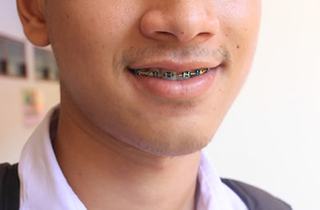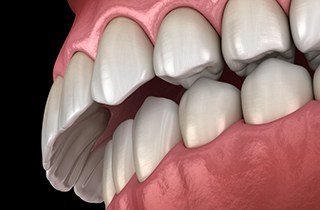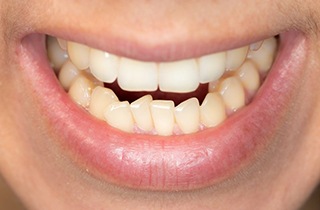Traditional Braces – DFW Metroplex
Beautifully Realign Your Pearly Whites
 Traditional braces have been used for decades to straighten teeth, correct bite alignment issues, and improve oral health, and patients of any age can use these proven orthodontic appliances to address malocclusions that can lead to numerous oral and overall health concerns if left untreated. Bear Creek Family Dentistry offers effective and compassionate orthodontic services to people in the DFW Metroplex, so please contact one of our locations to schedule a consultation. We’ll be happy to evaluate your smile and offer treatment recommendations to meet your needs.
Traditional braces have been used for decades to straighten teeth, correct bite alignment issues, and improve oral health, and patients of any age can use these proven orthodontic appliances to address malocclusions that can lead to numerous oral and overall health concerns if left untreated. Bear Creek Family Dentistry offers effective and compassionate orthodontic services to people in the DFW Metroplex, so please contact one of our locations to schedule a consultation. We’ll be happy to evaluate your smile and offer treatment recommendations to meet your needs.
Why Choose Bear Creek Family Dentistry for Traditional Braces?
- Thirteen Convenient DFW Locations
- Skilled and Experienced Orthodontists
- Flexible Financing Plans Available
How Do Traditional Braces Work?
 Advances in the materials and techniques used for traditional braces have made the treatment process more comfortable and efficient than ever before. These appliances use brackets, wires, and bands to gradually shift teeth into their ideal alignment over 12 to 24 months. The brackets are attached to the front surfaces of teeth while wires and bands exert pressure on them to shift the smile into better alignment. Patients will need to visit our office every four to six weeks during treatment so we can adjust the wires and bands appropriately to achieve the desired results.
Advances in the materials and techniques used for traditional braces have made the treatment process more comfortable and efficient than ever before. These appliances use brackets, wires, and bands to gradually shift teeth into their ideal alignment over 12 to 24 months. The brackets are attached to the front surfaces of teeth while wires and bands exert pressure on them to shift the smile into better alignment. Patients will need to visit our office every four to six weeks during treatment so we can adjust the wires and bands appropriately to achieve the desired results.
What Orthodontic Issues Can Braces Fix?
 The first step to receiving traditional metal braces is to schedule a consultation with one of our orthodontists. During this appointment, they will evaluate your mouth to determine the best way to address your malocclusion. Braces can treat problems like:
The first step to receiving traditional metal braces is to schedule a consultation with one of our orthodontists. During this appointment, they will evaluate your mouth to determine the best way to address your malocclusion. Braces can treat problems like:
Bite Misalignment
 Alignment issues like overbites, underbites, crossbites, and open bites can lead to a range of oral and overall health issues like sleep apnea, hygiene difficulties, a greater likelihood of damage and decay, and pain in the jaw, head, back, or neck. Braces can address these problems by shifting the teeth so they fit together properly when the mouth is closed.
Alignment issues like overbites, underbites, crossbites, and open bites can lead to a range of oral and overall health issues like sleep apnea, hygiene difficulties, a greater likelihood of damage and decay, and pain in the jaw, head, back, or neck. Braces can address these problems by shifting the teeth so they fit together properly when the mouth is closed.
Crowded & Crooked Teeth
 Crowded or crooked teeth are harder to clean, easier to injure, and more likely to become infected. Traditional braces can gradually straighten and space out these teeth so they can fit together evenly.
Crowded or crooked teeth are harder to clean, easier to injure, and more likely to become infected. Traditional braces can gradually straighten and space out these teeth so they can fit together evenly.
Gapped Teeth
 Gaps between teeth can provide space for plaque and food debris to accumulate and leave the gums more vulnerable to injury. Braces can bring your pearly whites closer together to create a healthier and more beautiful smile.
Gaps between teeth can provide space for plaque and food debris to accumulate and leave the gums more vulnerable to injury. Braces can bring your pearly whites closer together to create a healthier and more beautiful smile.
Caring for Your Braces
 Traditional braces require patients to practice to keep up with a special oral hygiene and maintenance regimen. This includes brushing and flossing several times a day as well as using special tools to clean between and around your brackets and wires. It’s also crucial to avoid hard or sticky foods that can break the archwire or pull the brackets out of place as well as acidic items that can leave unsightly dental stains and cause tooth decay. You’ll also need to keep up with regular follow-up appointments at one of our offices so we can ensure that your treatment is going smoothly.
Traditional braces require patients to practice to keep up with a special oral hygiene and maintenance regimen. This includes brushing and flossing several times a day as well as using special tools to clean between and around your brackets and wires. It’s also crucial to avoid hard or sticky foods that can break the archwire or pull the brackets out of place as well as acidic items that can leave unsightly dental stains and cause tooth decay. You’ll also need to keep up with regular follow-up appointments at one of our offices so we can ensure that your treatment is going smoothly.
Traditional Braces FAQs
Can I Get Traditional Braces on Just My Top or Bottom Teeth?
There are some patients who are candidates for single-arch treatment, but it’s quite rare. After all, moving only your top or bottom teeth can negatively impact your bite, leading to consequences like difficulty chewing and enunciating properly. With all of that said, don’t hesitate to ask us if this is an option at your consultation! Once we know more about your case, including the severity of the orthodontic problems at hand, we can determine if you’re eligible for single-arch treatment.
What Happens After You Get Your Braces Off?
Once we’ve moved your teeth and bite into proper alignment, we will transition our focus to the retention phase of your orthodontic treatment. This is crucial because – without it – your teeth can move out of place, wasting your valuable time and money in the process.
The first step is taking impressions of your teeth so a custom retainer can be made. Once it arrives at our office, you’ll come in for your final appointment, which is when we will make sure that it fits correctly, instruct you on when to wear it, and show you how to take care of it.
Important note: Even after your final appointment, you can give us a call if you have any questions pertaining to your orthodontic treatment or need a new retainer!
Do Traditional Braces Hurt?
It’s common for patients to feel soreness and discomfort, particularly when they first get braces as well as during the hours following their adjustment appointments. The good news is that there are several easy ways to prevent and alleviate symptoms like these – from sipping on cold water and eating only soft foods to taking OTC pain medication as directed. To put it simply, you shouldn’t let occasional pressure or sensitivity stop you from pursuing a healthier and even more beautiful smile!
Can I Chew Gum with Traditional Braces?
Since chewing gum can cause a bracket or wire to come out of place, we strongly advise against it. If you want to freshen your breath, reach for a mint instead (preferably a sugar-free one!).
What Can You Not Eat with Traditional Braces?
Basically, you want to avoid any foods that increase your risk of an orthodontic emergency, like a broken bracket. A few examples include thin pizza crust, popcorn, tortilla chips, raw celery, and whole apples. Fortunately, there are plenty of foods you can eat without compromising your orthodontic treatment, including cottage cheese, plain yogurt, oatmeal, bananas, and vegetable soup.
Important note: If you do sustain an orthodontic emergency, call us ASAP! We’ll walk you through how to handle it over the phone and, if necessary, schedule a same-day appointment at our office in the DFW Metroplex.
